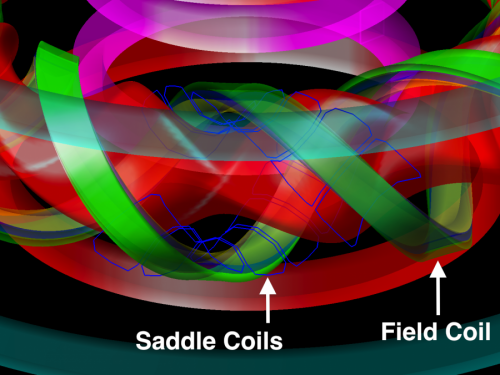A simulated plasma in the Large Helical Device showing the thin blue saddle coils that researchers used to make diagnostic measurements with the new computer code.
(Phys.org) —Scientists at the U.S. Department of Energy's Princeton Plasma Physics Laboratory (PPPL) and the National Institute for Fusion Science (NIFS) in Japan have developed a rapid method for meeting a key challenge for fusion science. The challenge has been to simulate the diagnostic measurement of plasmas produced by twisting, or 3D, magnetic fields in fusion facilities. While such fields characterize facilities called stellarators, otherwise symmetric, or 2D, facilities such as tokamaks also can benefit from 3D fields.
Researchers led by PPPL physicist Sam Lazerson have now created a computer code that simulates the required diagnostics, and have validated the code on the Large Helical Device stellarator in Japan. Called "Diagno v2.0," the new program utilizes information from previous codes that simulate 3D plasmas without the diagnostic measurements. The addition of this new capability could, with further refinement, enable physicists to predict the outcome of 3D plasma experiments with a high degree of accuracy.
Lazerson and co-authors Satoru Sakakibara and Yasuhiro Suzuki of NIFS have published their paper online in the February issue of Plasma Physics and Controlled Fusion. The journal also is using a Lazerson graphic of a simulated plasma on the cover of its print edition.
The researchers employed a mathematical technique called "virtual casing" to develop the new code for 3D fusion plasmas that are in equilibrium. Such plasmas are held steady by the balance between the inward pressure of the magnetic fields that confine them and the outward pressure exerted by the plasma. Virtual casing enabled the researchers to efficiently calculate magnetic diagnostic signals given a simulated plasma. This was achieved by recognizing that the magnetic field at the edge of the simulated plasma was all that was necessary to calculate the magnetic diagnostic signals.
The new code can be used with both the Variational Moments Equilibrium Code (VMEC) and the Princeton Iterative Equilibrium Solver (PIES). VMEC simulates a plasma that contains a set of smoothly nested magnetic field lines. In PIES simulations, the fields inside the plasma can break up into islands and be chaotically distributed. The new code's versatility thus enables it to simulate diagnostic measurements for both types of simulated plasmas.
Researchers are currently refining their code to reconstruct conditions that experimenters seek to create in fusion plasmas. Reconstructing these conditions calls for creating multiple iterations of the code through massive parallel processing, until the simulated measurements of the plasma precisely match the conditions measured in the experiment. Experimenters armed with this knowledge could then predict how the conditions they create in actual plasmas could affect the diagnostic outcome.
More information: dx.doi.org/10.1088/0741-3335/55/2/025014
Provided by Princeton Plasma Physics Laboratory



.jpg)


















